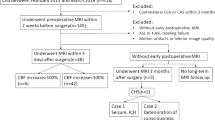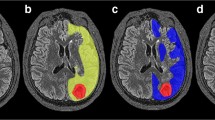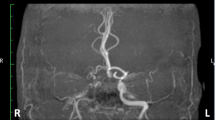Abstract
Introduction
Impaired cerebral vascular reserve (CVR) in patients with symptomatic internal carotid artery (ICA) occlusion is regarded as a possible indication for performing extra-/intracranial (EC/IC) bypass surgery. As perfusion MR imaging (MRI) can demonstrate cerebral haemodynamics at capillary level, our hypothesis was that perfusion MRI could be used in these patients for the evaluation of CVR following acetazolamide challenge in a similar way to single photon emission CT (SPECT) and might provide additional information.
Methods
Enrolled in the study were 12 patients (mean age 61.3 years; 11 male, 1 female) with symptomatic unilateral ICA occlusion proven by angiography. Both perfusion MRI and 99m-technetium-ethyl-cysteinate dimer (99mTc-ECD) SPECT were performed before and after injection of acetazolamide (Diamox ,1000 mg i.v.). CVR parameters including regional cerebral blood flow (rCBF) and volume (rCBV), and mean transit times (MTT) were measured by perfusion MRI.
Results
The patients with impaired CVR proven by SPECT (n = 9) had a negative mean rCBF increment (−46.52%), negative rCBV increment (−13.5%) and delayed MTT (mean +2.98 s), respectively, on the occluded side (Student’s t-test all P < 0.05). The patients with sufficient CVR (n = 3) had a mean rCBF increment of 1.2%, a decrement of rCBV of 10.46%, and a mean MTT shortening of 0.27 s following the acetazolamide injection.
Conclusions
Perfusion MRI before and after acetazolamide administration compares favourably with 99mTc-ECD SPECT for the detection of impaired CVR. The impact that perfusion MRI studies (before and after acetazolamide administration) might have on the treatment decision in patients with ICA occlusion has yet to be determined by a prospective study.




Similar content being viewed by others
References
Kleiser B, Widder B (1992) Course of carotid artery occlusions with impaired cerebrovascular reactivity. Stroke 23:171–174
Yonas H, Smith HA, Durham SR, Pentheny SL, Johnson DW (1993) Increased stroke risk predicted by compromised cerebral blood flow reactivity. J Neurosurg 79:483–489
Schmiedek P, Piepgras A, Leinsinger G, Kirsch CM, Einhäupl K (1994) Improvement of cerebrovascular reserve capacity by EC-IC arterial bypass surgery in patients with ICA occlusion and haemodynamic cerebral ischemia. J Neurosurg 81:236–244
Bushnell DL, Perlman SB (1997) Central nervous system. In: Wilson MA (ed) Textbook of nuclear medicine. Raven Press, New York, pp 239–245
van Everdingen KJ, Klijn CJ, Kappelle LJ, Mali WP, van der GJ (1997) MRA flow quantification in patients with a symptomatic internal carotid artery occlusion. The Dutch EC-IC bypass study group. Stroke 28:1595–1600
Nagata S, Fujii K, Matsushima T, Fukui M, Sadoshima S, Kuwabara Y, Abe H (1991) Evaluation of EC-IC bypass for patients with artherosclerotic occlusive cerebrovascular disease: clinical and positron emission tomographic studies. Neurol Res 13:209–216
Kuroda S, Houkin K, Kamiyama H, Mitsumori K, Iwasaki Y, Abe H (2001) Long-term prognosis of medically treated patients with internal carotid or middle cerebral artery occlusion: can acetazolamide test predict it? Stroke 32:2110–2116
Matsuda H, Higashi S, Kinuya K, Tsuji S, Nozaki J, Sumiya H, Hisada K, Yamashita J (1991) SPECT evaluation of brain perfusion reserve by the acetazolamide test using Tc-99m HMPAO. Clin Nucl Med 16:572–579
Raynaud C, Rancurel G, Tzourio N, Soucy JP, Baron JC, Pappata S, Cambon H, Mazoyer B, Lassen NA, Cabanis E (1989) SPECT analysis of recent cerebral infarction. Stroke 20:192–204
Kucharczyk J, Mintorovitch J, Asgari HS, Moseley M (1991) Diffusion/perfusion MR imaging of acute cerebral ischemia. Magn Reson Med 19:311–315
Schlaug G, Benfield A, Baird AE, Siewert B, Lovblad KO, Parker RA, Edelman RR, Warach S (1999) The ischemic penumbra: operationally defined by diffusion and perfusion MRI. Neurology 53:1528–1537
Wu O, Koroshetz WJ, Ostergaard L, Buonanno FS, Copen WA, Gonzalez RG, Rordorf G, Rosen BR, Schwamm LH, Weisskoff RM, Sorensen AG (2001) Predicting tissue outcome in acute human cerebral ischemia using combined diffusion- and perfusion-weighted MR imaging. Stroke 32:933–942
Wittsack HJ, Ritzl A, Fink GR, Wenserski F, Siebler M, Seitz RJ, Modder U, Freund HJ (2002) MR imaging in acute stroke: diffusion-weighted and perfusion imaging parameters for predicting infarct size. Radiology 222:397–403
Gillard JH, Hardingham CR, Kirkpatrick PJ, Antoun NM, Freer CE, Griffiths PD (1998) Evaluation of carotid endarterectomy with sequential MR perfusion imaging: a preliminary report. AJNR Am J Neuroradiol 19:1747–1752
Maeda M, Yuh WT, Ueda T, Maley JE, Crosby DL, Zhu MW, Magnotta VA (1999) Severe occlusive carotid artery disease: haemodynamic assessment by MR perfusion imaging in symptomatic patients. AJNR Am J Neuroradiol 20:43–51
Kikuchi K, Murase K, Miki H, Kikuchi T, Sugawara Y, Mochizuki T, Ikezoe J, Ohue S (2001) Measurement of cerebral hemodynamics with perfusion-weighted MR imaging. comparison with pre- and post-acetazolamide 133Xe-SPECT in occlusive carotid disease. AJNR Am J Neuroradiol 22:248–254
Yen YF, Field AS, Martin EM, Ari N, Burdette JH, Moody DM, Takahashi AM (2002) Test-retest reproducibility of quantitative CBF measurements using FAIR perfusion MRI and acetazolamide challenge. Magn Reson Med 47:921–928
Kim JH, Lee EJ, Lee SJ, Choi NC, Lim BH, Shin T (2002) Reliability of perfusion MR imaging in symptomatic carotid occlusive disease. Cerebral blood volume, mean transit time and time-to-peak. Acta Radiol 43:360–364
Mukherjee P, Kang HC, Videen TO, McKinstry RC, Powers WJ, Derdeyn CP (2003) Measurement of Cerebral Blood Flow in Chronic Carotid Occlusive Disease. Comparison of Dynamic Susceptibility Contrast Perfusion MR Imaging with Positron Emission Tomography. AJNR Am J Neuroradiol 24:862–871
Chang LT (1978) A method for attenuation correction in radiotnuclide computed tomography. IEEE Trans Nucl Sci 25:638–643
Slomka PJ, Radau P, Hurwitz GA, Dey D (2001) Automated three-dimensional quantification of myocardial perfusion and brain SPECT. Comput Med Imaging Graph 25:153–164
Marti-Fabregas JA, Catafau AM, Mari C, Mendoza G, Sanahuja J, Lleo A, Marti-Vilalta JL (2001) Cerebral perfusion and haemodynamics measured by SPECT in symptom-free patients with transient ischaemic attack: clinical implications. Eur J Nucl Med 28:1828–1835
Tanaka F, Vines D, Tsuchida T, Freedman M, Ichise M (2000) Normal patterns on 99mTc-ECD brain SPECT scans in adults. J Nucl Med 41:1456–1464
Yamashita T, Hayashi M, Kashiwagi S, Nakano S, Eguchi Y, Takasago T, Urakawa M, Ito H (1992) Cerebrovascular reserve capacity in ischemia due to occlusion of a major arterial trunk: studies by Xe-CT and the acetazolamide test. J Comput Assist Tomogr 16:750–755
Piepgras A, Schmiedek P, Leinsinger G, Haberl RL, Kirsch CM, Einhaupl KM (1990) A simple test to assess cerebrovascular reserve capacity using transcranial Doppler sonography and acetazolamide. Stroke 21:1306–1311
Widder B, Kleiser B, Krapf H (1994) Course of cerebrovascular reactivity in patients with carotid artery occlusions. Stroke 25:1963–1967
Ozgur HT, Kent WT, Masaryk A, Seeger JF, Williams W, Krupinski E, Melgar M, Labadie E (2001) Correlation of cerebrovascular reserve as measured by acetazolamide-challenged SPECT with angiographic flow patterns and intra- or extracranial arterial stenosis. AJNR Am J Neuroradiol 22:928–936
Spilt A, Van den Boom R, Kamper AM, Blauw GJ, Bollen EL, van Buchem MA (2002) MR assessment of cerebral vascular response: a comparison of two methods. J Magn Reson Imaging 16:610–616
Caramia F, Aronen HJ, Sorensen AG, Belliveau JW, Gonzalez RG, Rosen BR (1995) Perfusion MR imaging with exogenous contrast agents. In: Le Bihan D (ed) Diffusion and perfusion magnetic resonance imaging-applications to functional MRI. Raven Press, New York, pp 255–267
Kikuchi K, Murase K, Miki H, Yasuhara Y, Sugawara Y, Mochizuki T, Ikezoe J, Ohue S (2002) Quantitative evaluation of mean transit times obtained with dynamic susceptibility contrast-enhanced MR imaging and with (133)Xe SPECT in occlusive cerebrovascular disease. AJR Am J Roentgenol 179:229–235
Kim HS, Kim DI, Lee JD, Jeong EK, Chung TS, Yoon PH, Lee SK, Kim EJ, Yoon YK, Suh BC, Lee BI (2002) Significance of 99mTc-ECD SPECT in acute and subacute ischemic stroke: comparison with MR images including diffusion and perfusion weighted images. Yonsei Med J 43:211–222
Kuwabara Y, Ichiya Y, Sasaki M, Yoshida T, Fukumura T, Masuda K, Fujii K, Fukui M (1998) PET evaluation of cerebral hemodynamics in occlusive cerebrovascular disease pre- and postsurgery. J Nucl Med 39:760–765
Shiino A, Morita Y, Tsuji A, Maeda K, Ito R, Furukawa A, Matsuda M, Inubushi T (2003) Estimation of cerebral perfusion reserve by blood oxygenation level-dependent imaging: comparison with single-photon emission computed tomography. J Cereb Blood Flow Metab 23:121–135
Kim JH, Lee SJ, Shin T, Kang KH, Choi PY, Kim JH, Gong JC, Choi NC, Lim BH (2000) Correlative assessment of hemodynamic parameters obtained with T2*-weighted perfusion MR imaging and SPECT in symptomatic carotid artery occlusion. AJNR Am J Neuroradiol 21:1450–1456
Yokota C, Hasegawa Y, Minematsu K, Yamaguchi T (1998) Effect of acetazolamide reactivity on [corrected] long-term outcome in patients with major cerebral artery occlusive diseases. Stroke 29:640–644
Derdeyn CP, Grubb RL Jr, Powers WJ (1999) Cerebral hemodynamic impairment: methods of measurement and association with stroke risk. Neurology 53:251–259
Acknowledgement
We acknowledge Professor Tarek Yousry, MD, for his valuable input and for co-initiating this study. We thank Professor Gerhard Hamann for the thoughtful discussions in the course of the treatment decisions in our patient cohort.
Conflict of interest statement
We declare that we have no conflict of interest.
Author information
Authors and Affiliations
Corresponding author
Additional information
The first and second author contributed equally to this study.
Rights and permissions
About this article
Cite this article
Ma, J., Mehrkens, J.H., Holtmannspoetter, M. et al. Perfusion MRI before and after acetazolamide administration for assessment of cerebrovascular reserve capacity in patients with symptomatic internal carotid artery (ICA) occlusion: comparison with 99mTc-ECD SPECT. Neuroradiology 49, 317–326 (2007). https://doi.org/10.1007/s00234-006-0193-x
Received:
Accepted:
Published:
Issue Date:
DOI: https://doi.org/10.1007/s00234-006-0193-x




